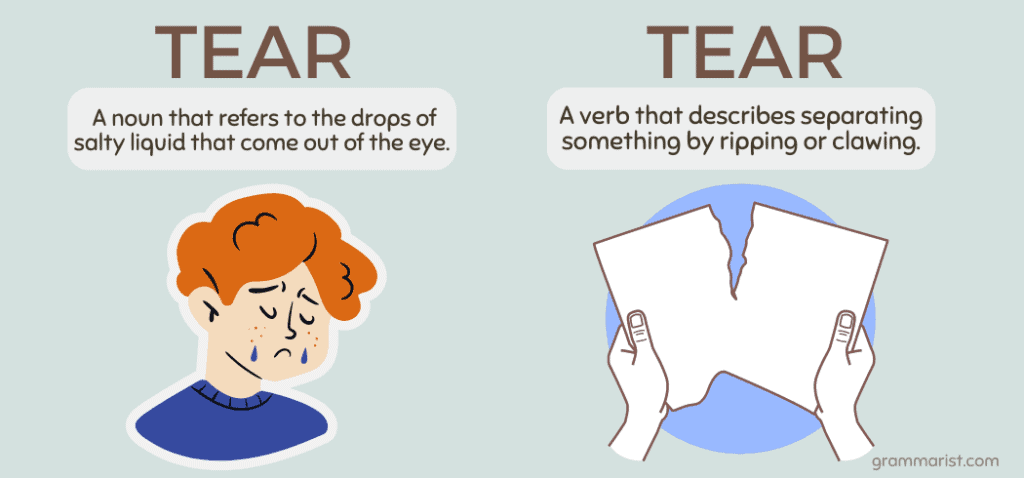Are you struggling to remember the difference between “tear” and “tear”? Don’t worry – we’ve all been there! Whether you’re a native English speaker or learning English as a second language, mastering new vocabulary can be challenging. But no matter your skill level, confusing words like these two can often feel like mission impossible!
In this quick guide, I’ll explain everything about the subtle nuances of “tear” and “tear” in minute detail so that by the end, you’ll have no trouble differentiating between them.
Tear vs. Tear
The words “tear” and “tear”‘ have different meanings in English, even though they are spelled the same. To tear something is a verb that describes separating something by ripping or clawing. For example, you could tear a piece of paper in half or tear fabric with scissors.
Tear is also a noun that refers to the drops of salty liquid that come out of the eye when one cries. Tears can be shed both due to joyous and sorrowful occasions, making it an emotion that transcends all moods.
What Are the 2 Meanings of Tear?
The word “tear” can refer to either the drops of salty liquid produced from a person’s eyes when they are feeling emotional or strong sensations, or it can mean to rip or pull apart something with force.
Externally, tears can be seen as physical proof that someone is deeply hurt or upset about a situation. As an action, tearing is most commonly associated with negative emotions such as anger and frustration.
When someone tears something in half, it often symbolizes their strong dissatisfaction. In both cases, the concept of ‘tear’ carries heavy connotations that conjure powerful mental images in the minds of those who hear its use.
What Is the Verb Tear?
The verb “tear” is defined as the physical act of rending or splitting apart. This term can be used to describe any kind of ripping, whether it’s paper being torn in half, clothing being ripped apart at the seams, or anything else along those lines.
Though it can sometimes have an inadvertent connotation of violence and destruction – such as when a large object is forcefully torn apart – its actual definition often implies something much less sinister.
Tear also has other uses, such as describing an emotional breakdown, figuratively implying that someone is “torn up” on the inside. It’s intriguing how this single word has multiple meanings and contexts that vary depending on how precisely they are employed.
What’s the Past Tense of Tear?
Most native English speakers are likely familiar with the past tense of “tear” as tore. While tore is the most common and accepted version, some may use the variant teared in certain scenarios.
The keyword “tore” is used when discussing physical events or actions that involve removal, such as tearing a sheet of paper, tearing cloth, or ripping something. However, “teared” is more commonly used when referring to emotions such as crying or shedding tears.
It is also used when discussing events that cause an emotional reaction, such as a sad story or news. As language evolves and conventions change across different geographical regions, both tore and teared can be considered appropriate based on context and local usage.
Why Are Tear and Tear Spelled the Same?
The English language is a fascinatingly nuanced and intricate form of communication. It has developed over time, often creating heteronyms: words with the same way of spelling but different meanings and pronunciations.
One example of this language quirk is the word “tear,” meaning either to rip or have something torn. Although it appears as one word, articulating its two versions relies on context. When speaking about a ripped piece of material, for instance, the pronunciation sounds like “tye-ur” or “tare,” whereas when referring to a drop from the eye, it is similar to “teer.”
While heteronyms – words with identical spelling but opposite meanings – are common in some languages, such as Japanese, this phenomenon still excites linguists and grammar fans who appreciate English roots’ intricacy.
Using Tear in a Sentence
When using it to refer to salty liquid coming from the eyes, here are some examples of how to use “tear” in a sentence:
- This story brought tears to my eyes.
- Whenever I see a romantic movie, I start to tear up.
- I won’t cry over that relationship anymore. The tears are not worth it.
Using Tear in a Sentence
When referring to something that was shredded to pieces, here is how to use “tear” in a sentence:
- The child tore her dress while playing outside.
- Your jokes always tear me up.
- He tore the envelope open and read the letter inside.
- Don’t tear up the letter I gave you!
- The dog tore up the newspaper that was left on the floor.
- I accidentally tore the page out of the book.
In a Nutshell
The words “tear” and “tear” may seem similar, but in fact, they have distinct definitions when used in the context of language.
A tear is a drop of saline liquid that is produced from the eyes due to an emotional reaction, such as sadness or grief. Conversely, tearing is a form of destruction achieved by pulling or stretching apart the material. This often manifests as an intentional act resulting in the separation of two objects or materials by force.
Although these two words may appear to be synonymous in their written forms, knowing their different meanings can help you avoid confusion when using them in conversation or writing.
Check out some others we covered:

